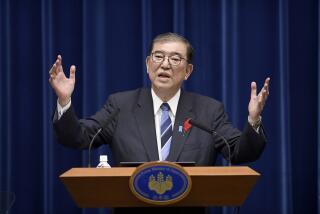Hashimoto Earns 2nd Term, Picks Conservative Cabinet
- Share via
TOKYO — Ryutaro Hashimoto was elected to a second term as Japan’s prime minister Thursday and picked a new Cabinet composed mainly of old-guard Liberal Democratic Party warhorses.
Breaking with tradition, Hashimoto also installed powerful party veterans--including several former Cabinet ministers--in the vital second-in-command ministry posts that are usually granted to fresh political talent.
Observers saw Hashimoto’s strategy as a bid to compensate for a weak political mandate with this double layer of experienced party loyalists--ministers he hopes will prove strong enough to escape capture by the entrenched and wily bureaucrats who tend to wield the real power in Japan.
Hashimoto has made reining in the overweening bureaucracy a top priority for his second term. The question is how well he will succeed in implementing his political agenda as head of a minority government.
The Liberal Democratic Party won 239 seats in the House of Representatives in last month’s elections, 12 seats short of a majority. Unable to form a coalition government, Hashimoto struck a loose alliance last month with his battered former allies, the Social Democratic Party and the New Party Harbinger, agreeing to work together toward some policy goals.
That deal gave Hashimoto the votes he needed to win the prime minister’s post on the first ballot Thursday.
Political analysts saw no major change in the U.S.-Japan relationship now that Hashimoto and President Clinton have both been reelected. However, Hashimoto’s survival may pave the way for progress on joint security issues. Washington has had to deal with a merry-go-round of short-serving Japanese prime ministers for more than three years. Hashimoto may have more leeway to pursue his conservative defense agenda now that he is not so tightly bound to a Socialist coalition partner.
Hashimoto’s new Cabinet includes only two holdover members, Foreign Minister Yukihiko Ikeda and Chief Cabinet Secretary Seiroku Kajiyama. The remaining 18 ministries were neatly parceled out among the LDP’s four main factions. The powerful intraparty clans are supposed to be withering away as part of Japan’s political reform process, but the factions have not disappeared yet.
The difficult job of running the Finance Ministry, which is slated to become the first agency to have its powers scaled back by the new parliament, went to Hiroshi Mitsuzuka, leader of one of the LDP’s biggest factions.
Mitsuzuka, 69, has held three previous Cabinet jobs, including stints as foreign minister and head of the Ministry of International Trade and Industry. As transportation minister in the 1980s, he presided over the privatization of the national railway system; now as finance minister, he will inherit the railway’s hangover of nearly $250 billion in debts.
Shinji Sato, 64, who as head of another LDP faction helped first get Hashimoto elected prime minister in January, is to run the international trade ministry. He once held that agency’s No. 2 political job as parliamentary vice minister of trade and also served as transportation minister.
Other key appointments include Fumio Kyuma, 55, to head the Japan Defense Agency, and Junichiro Koizumi, 54, an eight-term LDP veteran who is being tapped as minister of health and welfare for the third time. Koizumi, another faction head, is best known for advocating the privatization of the Japanese postal service.
The new Cabinet members include the son, son-in-law and grandson of former prime ministers and a relative by marriage of the emperor. The average age of the new ministers is 63. Only one woman--Michiko Ishii--was invited to join the Cabinet, as environment minister.
More to Read
Sign up for Essential California
The most important California stories and recommendations in your inbox every morning.
You may occasionally receive promotional content from the Los Angeles Times.












